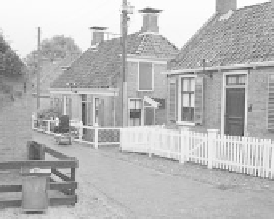Travel Reference
In-Depth Information
freshwater, and the later reclama-
tion and repurposing of land, the
traditional culture on display at this
museum became virtually extinct.
You'll meet people who do a con-
vincing job of role-playing no-non-
sense 1905 villagers. You're welcome
to take their picture, but they won't
smile—no one said “Have a nice
day” back then. On weekends, chil-
dren enjoy trying out old-time games, playing at the dress-up chest
(€1), and making sailing ships out of old wooden shoes (€2.50).
Cost and Hours:
€12.50, April-Oct daily 10:00-17:00; also
open Nov-March daily 10:00-17:00, but the buildings are closed,
making it a pricey ticket to see just the indoor museum and
deserted grounds; tel. 0228/351-111, www.zuiderzeemuseum.nl.
Getting There:
If you don't want to do the whole Historic
Triangle trip (described previously), it's also possible to take the
train to the museum from Amsterdam (or Haarlem). Trains make
the one-hour trip between Amsterdam and Enkhuizen every half-
hour. From the Enkhuizen station, take the shuttle boat or walk
20 minutes to the museum (see “Back to Amsterdam” at the end of
this tour).
>
Self-Guided Tour:
The Zuiderzee Museum is a delight to
explore. This tour is a start, but don't be afraid to poke into houses
(even if they seem to be populated) and backyards.
A museum attendant will greet you at the
dock
where the boats
arrive (from Medemblik and the Historic Triangle trip—described
above; or from the Enkhuizen train station—described under
“Back to Amsterdam,” page 280). Show your Historic Triangle
ticket, or (if you don't have one) buy a museum ticket. From here,
you can head to the right into a nature preserve, or go to the left to
the museum buildings. Follow signs for
Informatiecentrum
into the
row of brick houses, where you can pick up a map at the informa-
tion center.
The museum is organized into units. Use the map to visit these
in counterclockwise order. Throughout the open-air museum,
notice that every building has a little plaque with a brief English
description and a map showing the building's original location
in the Zuiderzee region. The first section, the
fishing village,
includes many residential homes that are fun to explore. On some
days (likely Tue and Thu), dressed-up locals populate the ram-
shackle village street from Urk—once a remote island across the
Zuiderzee, now a strange little lump on a vast, flat
polder.
Head to the
polder
area, near the windmill. In addition to
being a pretty symbol for the Netherlands, windmills like the one





















